Airless bottle is a high-end packaging composed of an outer cap, pump assembly, bottle body, internal large piston, and base tray. Its introduction aligns with the latest trends in cosmetics, effectively preserving the quality of the contents. However, due to its complex structure and relatively high production costs, the use of airless bottle is currently limited to a few high-end and high-demand products, making it difficult to fully penetrate the market and meet the packaging needs of cosmetics across different price ranges.
Manufacturing Process
1.Design Principle
The design of the ערלאַס פלאַש is based on atmospheric pressure and heavily relies on the pump’s output force. The pump assembly must have excellent one-way sealing performance to prevent air from flowing back into the bottle, creating a low-pressure state inside. When the pressure difference between the low-pressure zone inside the bottle and the atmospheric pressure exceeds the friction between the piston and the inner wall, the atmospheric pressure pushes the large piston forward. Therefore, the piston must not fit too tightly against the inner wall, as excessive friction would prevent movement. Conversely, if the fit is too loose, leakage may occur. Thus, airless bottles demand highly specialized production techniques.
2.Product Features
Airless bottle also provide precise dosage control. Once the diameter, stroke, and spring force of the pump assembly are set, the dispensed amount remains accurate and consistent regardless of the button design. The dosage can be adjusted by modifying pump components, with precision up to 0.05ml, depending on product requirements. Once filled, minimal air or moisture can enter the container from the factory to the end consumer, effectively preventing contamination and extending the product’s shelf life. In line with today’s eco-friendly trends and the call to reduce preservatives and antimicrobial agents, vacuum packaging plays a crucial role in prolonging product stability and protecting consumer rights.

Product Structure
1.Product Classification
By Structure: standard airless bottle, single-chamber composite airless bottle, dual-chamber composite airless bottle, non-piston airless bottle.
By Shape: Cylindrical, square (cylindrical being the most common).
Airless Bottles are typically cylindrical or oval, with common capacities ranging from 10 ml to 100 מל. Their small size and reliance on atmospheric pressure prevent contamination during use. The exterior can be treated with processes like aluminum, plastic electroplating, ספּרייינג, or colored plastics, but they are more expensive than standard containers. Minimum order quantities are relatively low.
2.Structural Diagram Reference
Key components of a airless pump bottle include: pump assembly, cap, button, outer sleeve, screw thread, gasket, bottle body, large piston, and base tray. Exterior parts can be decorated with electroplating, aluminum, ספּרייינג, or silk-screen printing, depending on design requirements. The pump assembly involves precision molds, which are rarely customized by clients. Its main parts include: small piston, connecting rod, spring, body, and valve.

3.Other Types of אַירלעסס פלאַשs
Fully plastic self-sealing valve airless bottle feature a movable disc at the bottom that rises as the product is dispensed. The bottle has an air hole at the base, with the disc separating the product above from the air below. When the product is fully used, the disc reaches the top of the bottle.
Cosmetic Applications
Airless bottles are widely used in the cosmetics industry, mainly for creams, lotions, serums, and liquid-based products.
Key Procurement Control Points
1.Vacuum Pump Testing
The pump assembly consists of: spring, valve (or sealing ball), small piston, and body (size determines the dispensed amount). The main challenge lies in ensuring airtightness among components. Due to the high sealing requirements, molds and parts must meet strict standards; otherwise, dispensing failure or leakage may occur. Each pump must undergo:
Dynamic testing (functional test to ensure stable operation).
Static testing (leakage prevention check to confirm protection of contents).
2.Airtightness of the אַירלעסס פלאַש
The friction between the large piston and the inner wall is critical—it affects both airtightness and piston movement. This balance is a core aspect of Airless Bottle performance.
3.Quality Assessment
During filling, ensure accurate volume. Test under the following conditions:
Place upright and sideways in a vacuum chamber at -0.05 MPa for ~5 minutes, then check for leaks.Verify consistent pump actuation and stable dispensing volume.










